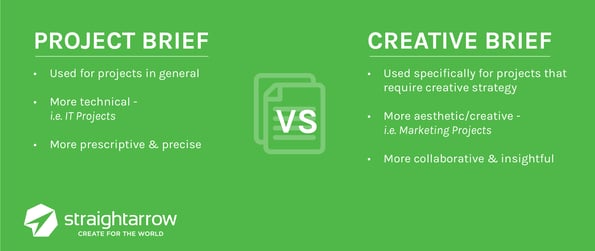
Simply put, a brief is a concise summary document that serves as a starting point for a collaborative project. Depending on the undertaking, a brief can take a more specific form such as a “project brief” or a “creative brief.”
These two briefs serve similar functions: they clarify the objective/s of the undertaking, specify a framework for it and provide the guidelines for the project team to follow.
The Similarities
Project and creative briefs provide a clear start and end point for an undertaking. They help clients and their service providers get on the same page and stay on the same page as they collaborate on a project. At a minimum, both should contain:
- The scope of the undertaking: exactly what is the project about? What’s included? What’s out-of-scope?
- The client’s objectives, ideally clearly stated in both qualitative and quantitative terms: what exactly does the client want to do?
- Guidelines, protocols, platforms to be used, if any: what can we do to achieve these objectives? What is “off-limits”?
- A backgrounder on the client/product/brand that is being represented: who or what is the project representing?
- A clear buyer persona/audience profile: who is the project for?
- Brand guidelines and other company standards: any “must’s” in terms of branding, colors, content, images, etc.
Briefs should be reviewed and approved or accepted by all parties involved in a project before any work begins. It’s an upfront investment in time that generates significant returns in efficiency and effectiveness over the project period. Oftentimes, the lack of a clear project or creative brief is the root cause of rework, failed user acceptance tests and overspends.
This isn’t to say that briefs cannot be revised after projects have started. However, when briefs are revised, everyone involved understands that there is a revision and that as a result, timelines and costs may be affected. In fact, agreeing on what to do when briefs need to change can be included in the brief itself by adding a section on “Change Orders” or “Amends”.

The Differences
A project brief clarifies what a project is all about. It answers the “who”, “what”, “where”, “when” and “why” of a project. It normally does not answer the “how” - which is a question answered by another document called the Project Plan. As projects are usually products to be made or processes to be created that are outside a company’s normal, day-to-day operations, clear project briefs are critical to their successful completion. Project briefs can show how a project fits into the bigger picture of a company’s business, like when:
- A business needs an app developed; they’ll take over managing it once development is complete; or
- A company needs someone to perform tasks outside their field of expertise, such as writing or editing technical content.
A project brief zeroes in on technical matters: deliverables, schedules, timetables, and logistics to work within the major constraints of scope, time, and budget. A good project brief will clearly show how a project team is expected to handle these constraints - what to prioritize and where to make adjustments.
A creative brief is used in projects that require creative strategy such as branding (or rebranding), ad campaigns and graphic or multimedia design. It helps clarify how a company, product, service or brand is positioned in its market.
In addition to the elements listed earlier, a creative brief may include references to past projects, business intelligence and competitive information, and results and/or insights from market research. It also usually includes significantly more and deeper information on target personas and key audiences. In this respect, creative briefs include relatively more subjective and qualitative information than project briefs. They will include taglines, logos and icons, colors and even moods.
Creative agencies can take the lead in developing a creative brief when their clients are not familiar in doing so. However, clients should always be accountable for the accuracy and completeness of these briefs and ultimately sign off on them.
Project and creative briefs are regularly used in outsourcing engagements, helping clients and their outsourced teams communicate effectively, collaborate more easily and successfully complete projects.
Download a free creative brief template here.
Automate your briefing process and track your collaborative processes with SmartSheets & StraightArrow’s Digital Marketing Automation set-up service. Book a call with us to learn how.


Originally posted by Ari Santiago on August 16, 2017. Updated by Haraya Del Rosario-Gust on February 9, 2021.



Comments